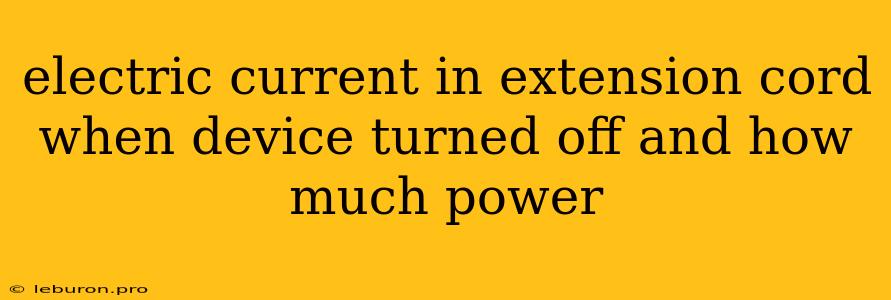Extension cords are ubiquitous in our homes and offices, providing a convenient way to extend electrical outlets and power our devices. However, a common question arises: does an extension cord still draw current when a device plugged into it is turned off? While the answer may seem obvious, there are nuances to consider. The amount of power an extension cord draws is directly related to the devices connected to it, and even when a device is turned off, a small amount of current can still flow through the cord. Let's delve into the intricacies of electric current in extension cords and explore the factors that contribute to power consumption.
The Power Dynamic: How much current flows?
The amount of electric current flowing through an extension cord is directly proportional to the load it is carrying. When a device is turned on and draws power, the current flows through the extension cord, ultimately reaching the device. This current flow is measured in Amperes (A).
Understanding Standby Power
Even when a device is turned off, it may still consume a small amount of power, known as standby power. This power consumption is necessary for certain functions like maintaining the internal clock, responding to remote controls, or allowing the device to quickly turn on when needed. This standby power, although small, can still draw a tiny amount of current through the extension cord.
The Role of Resistance
Every electrical component, including extension cords, has some inherent resistance. This resistance opposes the flow of electric current. When current flows through an extension cord, it encounters this resistance, leading to a small voltage drop across the cord. This voltage drop is proportional to the current flowing and the resistance of the cord. While this drop is typically negligible in a well-designed extension cord, it contributes to a small amount of power being dissipated as heat within the cord.
Factors Influencing Power Consumption
Several factors can influence the power consumption of an extension cord, even when a device is turned off:
- Type of Device: Devices vary significantly in their power consumption. Some devices, like a smartphone charger, might draw negligible power even when not actively charging a phone, while other devices, such as a microwave, can consume a considerable amount of power even in standby mode.
- Device Design: The design of a device can impact its standby power consumption. Newer devices often incorporate energy-efficient features that minimize standby power usage.
- Extension Cord Length: Longer extension cords have higher resistance due to the increased length of wire. This higher resistance can lead to a slightly higher power consumption, even when no device is connected.
- Extension Cord Gauge: The gauge of the wire in an extension cord refers to its thickness. Thicker wires have lower resistance, resulting in less power loss and a lower power consumption.
Measuring Current and Power Consumption
To accurately measure the electric current and power consumption of an extension cord, you can use a device called a power meter. This meter plugs into the outlet and measures the voltage, current, and power consumption of the connected devices. This information can provide insights into the power usage of your devices and help you identify potential energy-saving opportunities.
Importance of Safe Usage
It is crucial to use extension cords safely to prevent electrical hazards. Ensure that the extension cord's capacity matches the power requirements of the connected devices. Overloading an extension cord can lead to overheating, potential damage to the cord, and even fire hazards.
Conclusion
While it's true that an extension cord can still draw a small amount of electric current even when a device is turned off, this current flow is generally negligible and does not pose a significant energy concern. However, it's essential to be aware of standby power consumption and its potential impact. By using energy-efficient devices and practicing safe extension cord usage, you can minimize power consumption and reduce your environmental impact.
